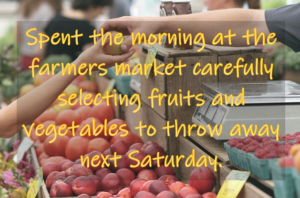 Have you experienced digging through your refrigerator produce drawer and discovering a moldy green pepper, shriveled-up limp greens or cauliflower covered with brown spots?
Have you experienced digging through your refrigerator produce drawer and discovering a moldy green pepper, shriveled-up limp greens or cauliflower covered with brown spots?
You had such great intentions to use these, but they got buried at the bottom of the drawer, left undiscovered, until it was too late…so, into the trash they go!
We have done this more often than we care to admit!
There is nothing more frustrating, when it comes to food, than the feeling of being wasteful. Someone worked so hard to plant, grow and harvest this food and we are throwing it in the trash. Not to mention the money that we just wasted!
Believe it or not, as much as 40% of the food in the U.S. is thrown away, and most of it ends up in landfills. For an average family of four, this food that gets thrown out can easily be worth over $1,000. Just think what you could do with that $1,000 every year! We all know why it happens…we forget about those perishables until it’s too late, we purchase too much, or we cook big meals and then end up throwing away the leftovers.
What can we do to reduce this waste?
 Plan your meals!
Plan your meals!
And use a shopping list! A little planning for your week ahead means you know EXACTLY what you need from the farmers’ market or store.
Using a shopping list allows you to buy just what you need, reducing the potential for waste (and saving you time in the process)!
This is where your customizable Eat REAL America shopping list (accessible on your phone) comes in very handy!
Resist impulse purchases!
This is obviously an important tip when it comes to processed foods (resisting the Snickers bar in the check-out line), but it also applies to perishable foods…just because pears are on sale and look delicious, resist the urge if you don’t have a “plan” for them. You don’t want to be throwing them away in two weeks.
First in, first out…
Store your produce and other perishables with the oldest items (that need to be used first) in the front or on top.
Weekly Fridge Clean-out!
Make every Friday or Saturday a “clean out the fridge stir-fry or soup night.” No matter what’s served, make it a stir-fry (or make soup) using any left-over half heads of cauliflower, broccoli stalks, half onions, left-over protein or whatever else you have on hand before you stock up on food for the next week. This simple weekly habit can help prevent ANYTHING from going bad on you!
Get creative with leftovers!
See how easy it can be to turn your leftovers into another meal such as with our 2-for-1 meals. Enjoy leftovers for lunch the next day, or even breakfast — you would be amazed how many dinners can be turned into delicious breakfasts by simply adding an egg on top the next morning! You will also be amazed at how much money you can save by making leftovers part of your routine!
 Use the search bar!
Use the search bar!
If you a leftover ingredient you don’t know what to do with, type it into the Eat REAL America search bar and the let the ideas come to you!
Nose to tail, or stem to end…eat it all!
How many times have you thrown away beet greens or carrot top greens? Instead, try transforming them into pesto! What about those broccoli stalks or Swiss chard stems? They are great sautéed in a skillet, roasted in the oven, shredded for slaw or used in smoothies! Another great trick is to save all your vegetable scraps and turn them into homemade broth. You can save these scraps, store them in a freezer Ziploc or plastic container and once you have enough, add them with water to a slow cooker and transform them into a delicious homemade vegetable broth! See our coaching tip for more tricks how to prepare and store homemade broth.
Where do they like it best?
Storing foods at the right temperature can help you maximize their longevity. There was once a time when we stored tomatoes in the refrigerator, but quickly learned this made them go bad faster, and it reduced their flavor. Tomatoes, as well as other veggies such as squash and melons, are best stored at room temperature, until cut.
This article from the NY Times provides great perspective on how a tomato’s flavors actually change as soon as it is picked from the vine and the changes that occur when stored in the fridge.
Refrigerate your nuts!
Because of their natural oil content, nuts can go bad faster when exposed to light and heat. Storing nuts in the refrigerator, in airtight containers or bags, will extend their freshness, up to one year! And, storing them in the freezer can extend their life even longer. Nuts can absorb odors from their environment, so it is best to store them in airtight plastic containers or sealed bags.
 Pickling!
Pickling!
Do you have excess fruits or veggies you don’t know what to do with?
Try pickling them…it is super-easy and they are super-delicious! See our tips on quick pickling.
Freezing is the perfect way to stop food waste!
You can freeze so many things, including fresh herbs in ice cube trays, plus pesto, canned pumpkin, and an endless variety of fruits and vegetables, leftover soups and stews and so much more!
In fact, Zonya says:
ENERGY BANK IT!
If you have one extra left-over serving of soup or stew that’s probably not going to be enjoyed this week, then ENERGY BANK it. That means pop it into the freezer, label it and date it. Reserve one shelf of the freezer for these single serving planned-overs, for a day when you have “zero energy” to pack a lunch for yourself. You will be glad you did!
Understand expiration dates!
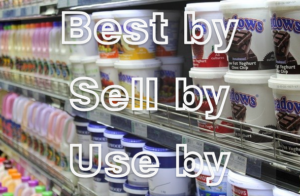 All those caution dates, such as “Sell by,” “Best by” and “Use by,” are focused on quality, not safety.
All those caution dates, such as “Sell by,” “Best by” and “Use by,” are focused on quality, not safety.
Keep this in mind and use your best judgement…smell, sight and taste are the best ways to tell if something is “going bad.” Of course, beware of mold, green potatoes (bad sign), and rancid meat, oils and nuts.
Don’t discriminate!
We provided a coaching tip on ugly fruits and vegetables. You can often get great deals on this produce that provide the same taste and nutrition as their perfect-looking counterparts. Give them a good home so they don’t get thrown out!
Stale bread?
Turn it into croutons! As simple as cutting into small pieces, tossing with a little olive oil, salt and pepper, and then toasting in the oven! In just a few minutes, you will have crunchy croutons!
 Hit the Salad Bar!
Hit the Salad Bar!
If you need small amounts of fresh ingredients, consider shopping from the salad bar at your local store…then you can buy the exact amount of what you need!
Share with Others!
Share those big meals with your neighbors or friends, especially if you know the leftovers will not all get eaten in your house! Better yet, see if they will return the favor and then it’s a win-win!
If all else fails…
Consider composting! This is a great way to teach kids about recycling.
These ideas are all great ways to save money, contribute to protecting the environment and ensure that the hard work of the farmers doesn’t go to waste! We would love to hear your ideas on how to reduce food waste!

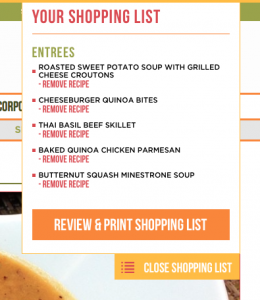

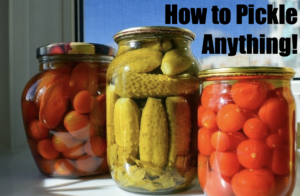
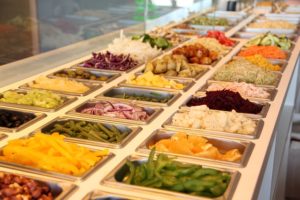
Leave A Comment